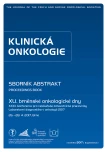The Importance of MicroRNA Deregulation in the Molecular Pathogenesis and Histological Transformation of Follicular Lymphoma
Authors:
K. Musilová 1,2; J. Deván 1,2; L. Zlámalíková 3; L. Křen 3; H. Mociková 4; V. Procházka 5; J. Mayer 1; M. Trněný 6; A. Janíková 1; M. Mráz 1,2
Authors‘ workplace:
Interní hematologická a onkologická klinika LF MU a FN Brno
1; Centrum molekulární medicíny, CEITEC – Středoevropský technologický institut, MU, Brno
2; Ústav patologie, FN Brno
3; Interní hematologická klinika 3. LF UK a FN Královské Vinohrady, Praha
4; Hemato-onkologická klinika LF UP a FN Olomouc
5; I. interní klinika – klinika hematologie 1. LF UK a VFN v Praze
6
Published in:
Klin Onkol 2017; 30(Supplementum1): 163-165
Category:
Article
Overview
Background:
Molecular pathogenesis of follicular lymphoma (FL) is characterized by substantial dysregulation of epigenetic regulators. Many cases of FL are associated with the aberrant expression of non-coding regulatory RNAs, namely microRNAs (miRNA). Here we studied changes in miRNA expression and their association with histological transformation of FL to diffuse large B-cell lymphoma (DLBCL).
Material and Methods:
To identify changes in miRNA levels during FL transformation we performed a global expression analysis of 377 miRNAs in 16 samples (8 pairs) from FL patients vs. transformed FL (tFL) (TLDA miRNA cards; Thermo Fisher Scientific). The association of miRNA expression with clinical-biological characteristics and target proteins were further analyzed in a cohort of 89 FL patients.
Results:
The miRNA expression profiling of paired FL-tFL samples revealed statistically significant changes in the expression of five miRNAs (p < 0.05). Four of them were down-regulated and one was up-regulated in tFL compared to FL. Lower levels of one of these miRNA were also associated with higher proliferation rate of FL cells (Ki-67 > 20%), higher FLIPI score (≥ 3) and shorter overall survival of FL patients. Furthermore, we found that this miRNA regulates the levels of FOXP1 protein in FL. The patients with high-level FOXP1 expression (> 70% positive cells) had significantly shorter overall survival in comparison to those with low-level FOXP1 expression (< 30% positive cells). Moreover, FOXP1 protein levels were higher in most tFL samples compared to FL before transformation.
Conclusion:
We found miRNAs associated with the transformation of FL to a more aggressive DLBCL, and described that one of them could serve as a prognostic marker. We found that reduced expression of this tFL-associated miRNA results in increased levels of FOXP1 protein and we assume that the increased activity of FOXP1 proto-oncogene contributes to the histological transformation of FL.
Key words:
follicular lymphoma – microRNA – histological transformation
This work was supported by Czech Ministry of Health registration No. 16-29622A. All rights reserved.
The authors declare they have no potential conflicts of interest concerning drugs, products, or services used in the study.
The Editorial Board declares that the manuscript met the ICMJE recommendation for biomedical papers.
Submitted:
5. 3. 2017
Accepted:
26. 3. 2017
Sources
1. Benešová K, Trněný M. Folikulární lymfom. Klin Onkol 2015; 28 (Suppl 3): 3S73–3S79. doi: 10.14735/amko20153S73.
2. Tsujimoto Y, Cossman J, Jaffe E et al. Involvement of the bcl-2 gene in human follicular lymphoma. Science 1985; 228 (4706): 1440–1443.
3. Okosun J, Bödör C, Wang J et al. Integrated genomic analysis identifies recurrent mutations and evolution patterns driving the initiation and progression of follicular lymphoma. Nat Genet 2014; 46 (2): 176–181.
4. Pasqualucci L, Khiabanian H, Fangazio M et al. Genetics of follicular lymphoma transformation. Cell Rep 2014; 6 (1): 130–140. doi: 10.1016/j.celrep.2013.12.027.
5. Thompson MA, Edmonds MD, Liang S et al. miR-31 and miR-17-5p levels change during transformation of follicular lymphoma. Hum Pathol 2016; 50: 118–126. doi: 10.1016/j.humpath.2015.11.011.
6. Mráz M, Doubek M, Mayer J. Inhibice signalizace B buněčným receptorem: první cílená léčba u chronické lymfocytární leukemie a dalších B buněčných lymfomů. Klin Onkol 2013; 26 (3): 179–185.
7. Musilova K, Mraz M. MicroRNAs in B-cell lymphomas: how a complex biology gets more complex. Leukemia 2015; 29 (5): 1004–1017. doi: 10.1038/leu.2014.351.
8. O’Donnell KA, Wentzel EA, Zeller KI et al. c-Myc-regulated microRNAs modulate E2F1 expression. Nature 2005; 435 (7043): 839–843.
9. Mraz M, Chen L, Rassenti LZ et al. miR-150 influences B-cell receptor signaling in chronic lymphocytic leukemia by regulating expression of GAB1 and FOXP1. Blood 2014; 124 (1): 84–95. doi: 10.1182/blood-2013-09-527 234.
10. Banham AH, Connors JM, Brown PJ et al. Expression of the FOXP1 transcription factor is strongly associated with inferior survival in patients with diffuse large B-cell lymphoma. Clin Cancer Res 2005; 11 (3): 1065–1072.
11. Green MR, Gandhi MK, Courtney MJ et al. Relative abundance of full-length and truncated FOXP1 isoforms is associated with differential NFkappaB activity in follicular lymphoma. Leuk Res 2009; 33 (12): 1699–1702. doi: 10.1016/j.leukres.2009.05.004.
Labels
Paediatric clinical oncology Surgery Clinical oncologyArticle was published in
Clinical Oncology

2017 Issue Supplementum1
Most read in this issue
- Ascites May Provide Useful Information for Diagnosis of Ovarian Cancer
- Lactate Dehydrogenase – Old Tumour Marker in the Light of Current Knowledge and Preanalytic Conditions
- Molecular Pathology of Colorectal Cancer, Microsatellite Instability – the Detection, the Relationship to the Pathophysiology and Prognosis
- Circulating Myeloid Suppressor Cells and Their Role in Tumour Immunology
